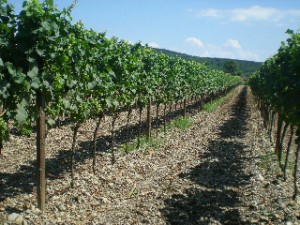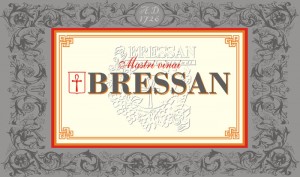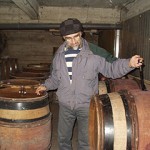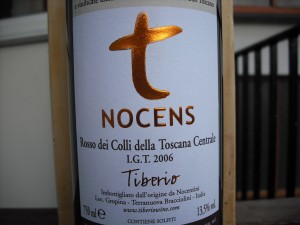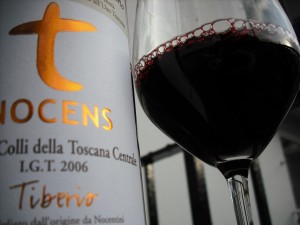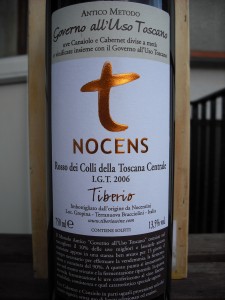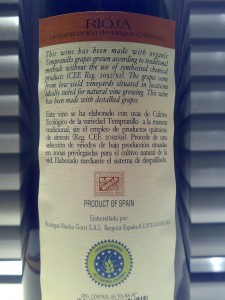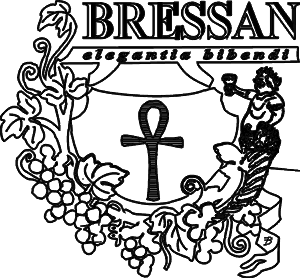 BRESSAN mastri vinai
Via Conti Zoppini, 35
34070 FARRA D’ISONZO (Gorizia)
Italy
Tel. +39 – 0481 – 888131
Fax +39 – 0481 – 889824
E – mail: bressanwines@tin.it
www.bressanwines.com
www.bressanwines.it
BRESSAN mastri vinai
Via Conti Zoppini, 35
34070 FARRA D’ISONZO (Gorizia)
Italy
Tel. +39 – 0481 – 888131
Fax +39 – 0481 – 889824
E – mail: bressanwines@tin.it
www.bressanwines.com
www.bressanwines.it
I haven’t done too many “producer profiles” so far, and I suppose that’s because I really have to believe in the philosophy of the producer before I feel compelled to write about them. Then, I really have to like the wines. I may have a favorite bottle, but overall, I tend to enjoy all of the wines the producer makes. Usually the wines will have a certain signature that says they all belong to a certain family – in this case we’re talking about the philosophy and wines of Mastri Vinai Bressan, and that signature is one of passion and patience. Patience enough to release a wine that, although is certainly age worthy, is actually ready to drink upon release. And this is why I have selected to write about Bressan.
The Bressan family owns about 20 hectares in the Friuili-Venezia Giulia appellation in North-Eastern Italy on the border to Slovenia. The first thing that struck me about this producer was of course the wines. Indigenous varieties that one does not taste every day, such as the Schioppettino, Pignol and Verduzzo Friulano. The second thing that struck me was the vintage of some of these wines which went back as far as 1999 (the latest release of the Pignol, for instance). The third thing that struck me was the philosophy of this producer. A philosophy very much in line with what I feel a wine producer’s philosophy should be.
The philosophy of the producer is very important to me. I focus mostly on wines that are organic, biodynamic and natural. It is not important to me if the producer is certified organic or biodynamic and I have said this before. After all, getting a certification is sometimes done for the wrong reasons. I am not excluding producers that ARE certified, I am just stating that an attitude and philosophy are in my opinion more important.
Fulvio Bressan says the following: ” I am not ‘organic’, even my own personal rules impose conditions in the vineyard and wine-cellar that are more severe than those of various ‘certifications’ “. He adds ” I am not bio-dynamic because I know unfortunately that the rules can be superseded by fashion and I know that nothing is easier than imposing rules and then breaking them, thus profiting from the naiveté of others… ” And, goes on to say ” The majority of wines produced today around the world are made mediocre, deprived of character, standardized, unable to challenge Time due to the indiscriminate use of chemicals both in the vineyard and the wine-cellar. This method of working deadens the traces of the grapevine, the features of the territory and the personality of the producer “. You can read more about his approach and philosophy here. It’s very interesting and worth a read!
And now on to the vines and wines. The wines of Bressan are made using only proprietary grapes. He does not sell or buy grapes. In fact, if the vintage is not a good one, Bressan chooses to simply let his grapes hang on the vines and fall to the floor and back into the soil in which they came. This way, nobody else can say they produce wines with the grapes of Bressan. His neighbors think he’s crazy, but he feels if his name is going to be on the bottle, it needs to be representative of his values. He says he will probably never get rich, but he will always be able to look into the eyes of people he has in front of him.
All the work they do in the vineyards and in the wine cellar is done with the maximum respect for nature, the grapes and the people who drink their wines (“wine should be a medicine not a poison as in many cases”). Here are the rules they have always followed:
- Manual selection of the vines and preferential use of indigenous varieties (cloning and all forms of genetically-modified organisms are forbidden)
- Pruning and removal of shoots is performed exclusively by hand
- Personal cultivation of the vineyard without the use of synthetic chemical substances, respecting vine and its natural cycles (total exclusion of herbicides and/or fungicides and/or pesticides)
- Exclusive use of natural fertilizers, from vegetables or from the barn, or else none at all
- Irrigation is forbidden even as relief, as water has always diluted the aromatic wealth and intensity of the wine
- The harvest is done manually to obtain perfectly healthy and mature grapes (no premature harvesting)
- Fermentation is obtained thanks to indigenous yeasts naturally present in the grape, absolutely excluding the use of synthetic industrial yeasts.
- No sulfurs anhydrides are added to the must, nor are other additives / chemicals (sulfurs anhydrides might be added only in small quantities at the moment of bottling and in any case in quantities that are lower or equal to biological certification)
- The use of biological and/or chemical aromas is forbidden
- Maturation of the wine in its own “fine lees” up to bottling
- No filtration (a practice which in any case always impoverishes and sterilizes the wine)
- Exclusive use of cork, rigorously limited to natural single pieces, so that each wine will have Time as its best ally
- Rigorously manual labeling (… each bottle is a unique creature… )
I will do complete tasting notes on 5 of Bressan’s wines over the next few days, so check back for some exciting wines and tasting notes!! Happy Holidays!!
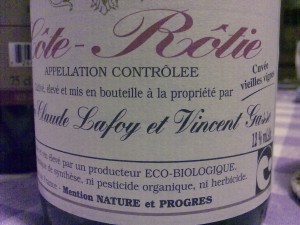 Date tasted: October 8th, 2009 at 23:00
Date tasted: October 8th, 2009 at 23:00
The Philosopher Grower Vincent Gasse lives just outside the main village of Ampuis, in the northern hamlet of Verenay, in the AOC Côte-Rôtie. From here he conducts his private campaign – to solve the conflict of making truly organic wine off slopes that crumble when you hand work their soil.
Vincent likes to stay out of the limelight. At 60 he is professorial, with a beard and what could be called wild hair, prominent bushy eyebrows, and glasses. In 2004 he decided to hang up his boots, and made just four casks of Côte-Rôtie from his plot on Le Goutay. His 1.3 hectares of vineyards, spread across five plots – Côte Rozier, Leyat, and Le Goutay on the full slopes and Bonnivière and Ritolas nearer the plateau – have been rented out to his fellow worker of the past seven years, Stéphane Otheguy. The oldest are Leyat and Bonnivière – both around 1945-1955 and planted by Marie Lafoy’s father, Pierre. The rest vary between 1985-1999.
Vincent makes his wine in the most constructive way possible since he feels strongly that the world’s resources are being rapidly depleted. He therefore carefully selects his vine stock, takes special care in the vineyards and when he makes the wine.
Vincent works organically (éco-biologique) and says that there are enormous extra costs in doing so. “The one big problem, he says, is how to work the soil – the rest of the issues can be solved”
“On slopes, manual weeding and working will take 1,000-plus hours, versus just 10 hours if you spray weedkiller,” he continues. “Say the weather is bad, you go up to 1,500 hours. And where are you going to find the people prepared to do this hard work? The challenge lies in the very word ‘Côte-Rôtie’ – which the next generation is going to have to find an answer to if they want to make true organic farming here economically sound.”
His first destalking was in the early 1990’s and vinification was in one open wood and one open concrete vat. No cultured yeasts have ever been used, and after a cool maceration, vinification would last over three weeks.
The two-year ageing was done in used 228-liter casks (of 2nd, 3rd or 4th passing). All the wine was bottled, without fining or filtration. The first bottling was in 1988, and there was Cuvée Sophia made from under 20-year Syrah off Côte Rozier and Ritolas, and a Vieilles Vignes (for this tasting note) from old vines that are purely massale selection (the practice of propagating new plant material from numerous selected mother vines in the vineyard), without any clonal presence.
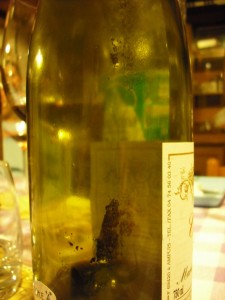 Soil: Schist and clay
0,4 ha organic vineyard
Guyot system
8800 vines per hectare
55 year average age of vines
39,5hl per hectare
100% hand harvest
Spontaneous fermentation
22 months on the fine lees in used barriques
No clarification or filtration
25 mg/liter total SO2
2100 bottles produced
Soil: Schist and clay
0,4 ha organic vineyard
Guyot system
8800 vines per hectare
55 year average age of vines
39,5hl per hectare
100% hand harvest
Spontaneous fermentation
22 months on the fine lees in used barriques
No clarification or filtration
25 mg/liter total SO2
2100 bottles produced
Tasting Notes:
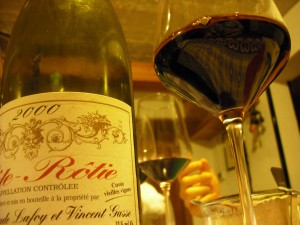 Appearance: Dark purplish-red with slight brownish edge. Medium plus intensity.
Appearance: Dark purplish-red with slight brownish edge. Medium plus intensity.
Nose: Medium intense, highly complex wine with aromas of cranberries, blackberries and wild raspberries. Spice, white pepper with a mineral backbone. Extremely complex bouquet with hints of black olives. Very intriguing and complex nose. Enticing.
Palate: Blackberries, wild cherries, cranberries, spice, dark olives with gripping medium level tannins with medium/high, mature acidity that carries the wine to a seemingly never-ending mineral finish. Very balanced and an impressive wine with only 12% alcohol. Very fresh and very drinkable. One of the freshest and lightest, yet concentrated Côte-Rôtie’s I’ve tasted. An impressive feat considering the very warm 2000 vintage which typically produced high alcohol, jammy wines.
(Thanks to John Livingstone-Learmonth’s “The Wines of the Northern Rhône” pages 93-95 for the Domaine and Vincent Gasse information used in this post)
]]>
Italia +39 338 4604806 www.tiberiowine.com
Date tasted: September 9th, 2009 18:30 (6:30pm)
The Nocens is Tiberio’s top wine and is made from Cabernet Sauvignon and Canaiolo in equal parts. The grapes are farmed organically and are grown in Chianti D.O.C vineyards. Grapes are harvested by hand. The wine is designated “Rosso dei Colli della Toscana Centrale (I.G.T)”
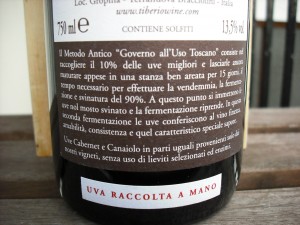 The Nocens is made in the “Antico Metodo Governo all’ Uso Toscano“. A pre-harvest selection of 10% of the top grapes are harvested by hand and placed in a well-ventilated room to let them finish maturing (and drying) for about 15 days, time enough to finish the rest of the harvest. The rest of the grapes are also harvested by hand and fermented spontaneously using indigenous yeast and without the use of enzymes. Once the fermentation is completed, the pre-harvest “Antico Metodo Governo all’ Uso Toscano” grapes that were set aside are added to the wine and a second fermentation commences (think “Ripasso” from the Veneto here). The wine is then aged for 12 months in 225-liter French Barriques. The wine is bottled without filtration
The Nocens is made in the “Antico Metodo Governo all’ Uso Toscano“. A pre-harvest selection of 10% of the top grapes are harvested by hand and placed in a well-ventilated room to let them finish maturing (and drying) for about 15 days, time enough to finish the rest of the harvest. The rest of the grapes are also harvested by hand and fermented spontaneously using indigenous yeast and without the use of enzymes. Once the fermentation is completed, the pre-harvest “Antico Metodo Governo all’ Uso Toscano” grapes that were set aside are added to the wine and a second fermentation commences (think “Ripasso” from the Veneto here). The wine is then aged for 12 months in 225-liter French Barriques. The wine is bottled without filtration
Appearance: Clean. Medium dark red with hints of blue. Medium to medium low intensity.
Nose: Clean. Medium intense nose of dark cherries and wild black currants with hints of cedar and eucalyptus. Medium complex wine with well-integrated oak on the back end.
Palate: Clean. Good fruit on the front end. Sour cherries, black currants and blackberries. Good structure and good acidity carrying the wine to a medium-long finish with medium tannins. Oak is well-integrated, but noticeable lending to the tannic structure of this wine. Very well integrated alcohol at 13,5%
Overall impressions: This is a well-made wine with good structure, balance and clean fruit which should be a pretty good wine to match with food. I am thinking a grilled steak, or grilled vegetables would be a nice complement to this wine. This being said, the oak is too dominant for my palate, but I feel that many people will enjoy this wine. It sits nicely between a modern-made wine and one made traditionally. In my opinion, this wine can be stored for a few more years, but I don’t think that it will improve so I would drink it now.
I have tasted other Tiberio wines and find his fruit to be clean, precise and on the feminine side (especially his Sangiovese, my favorite of his wines) and I feel that his wines would be better represented if they weren’t stored in oak. For those of you who share my feelings on this, rumor has it that he is playing with some un-oaked versions of his wines as I write this and perhaps I will have the opportunity some day soon to taste as stainless steel version of his Sangiovese.
]]>
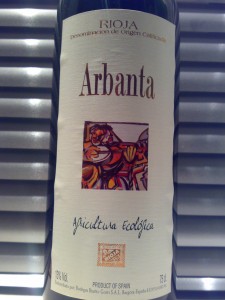 Date tasted: May 7th, 2009
Date tasted: May 7th, 2009
Not only is this wine certified organic, but it’s also somewhat of a rarity of the wine world. In the Rioja region of Spain, wines have traditionally been aged in oak (with exception are the Joven wines which may not see any oak at all). And I am being kind here because not only have wines from Rioja been traditionally aged in oak, but often wines were aged for many many many years in oak. It wasn’t uncommon to see wines, including whites, to be stored in oak for 20 years, although 2-5 years was more usual. On top of that, American oak was often used imparting in my opinion, well you know, unwanted flavors in the wine often covering up the beautiful fruit.
The fruit in this case being the very underrated (by some) Tempranillo grape. “The little early one” as it’s called due to the fact that it usually ripens a few weeks earlier than other Spanish varieties, is a grape that can produce full-bodied wines with a huge aging potential. Not only can they age for decades, but they do so gracefully. At a “blind” wine tasting that I attended last year with fellow enthusiasts, half the group mistook a 1982 Rioja for a Burgundy (Pinot Noir) while the other half mistook the wine as a Barolo (Nebbiolo)! No joke, and we were a pretty talented bunch!
Now on to this wine. The bodega Biurko Gorri is a family run estate with one aim “they use their wine-making tradition and great care of their vineyards along with very modern installations to produce and age high quality wines“. The vineyards are found on the sunny slopes in the area at an altitude that give the grape an excellent balance of acidity and ripeness. The fruit grows on old vines (15-20 years) and most of the 30ha are organic; organic fertilizers are used, not herbicides nor synthesized chemicals. The wines made from these grapes go on sale under the Denominación de Origen Ecológica as well as the D.O.C. Rioja.
This Arbanta wine comes from organic vineyards in carefully chosen well-ventilated areas at high altitudes. The vineyards are located in the small town of Bargota in the foothills of the Sierra Cantabria Mountains. The grapes are destalked. Fermentation is with natural yeasts in stainless steel vats at controlled temperatures between 20 and 28ºC. Natural fining through decanting and racking.
Appearance: A very youthful reddish purple. Good color concentration with a medium intensity.
Nose: Wild strawberries and other berries. Plums and flowers. Mineral undertones. Hints of orange peel and anise.
Palate: Plums, blackberries and hints of sweet licorice. Nice gripping tannins with a long mineral aftertaste. Great concentration. Light & fresh with medium acidity.
A wine to be enjoyed young. No sense aging this wine as it’s so good and fresh now. I would enjoy this wine with some grilled light colored meets like chicken, or some aged hard cheese. If you like fish with red, this could be an option as well.
I am extremely happy to live in a time when new wave Rioja wine makers are reducing oak use to such a degree that some are skipping the oak all together. It allows us to better understand the fruit as the fruit becomes clear without the clutter of artificial (oak) additives.
]]>Here I am uploading another video! My confidence and overall video quality is still not where I want them to be. I appreciate your continued support as I continuously work on improving these videos! Enjoy
Wine Tasting with Vinosseur – Bründlmayer Grüner Veltliner Kamptaler Terrassen 2007 from vinosseur on Vimeo.
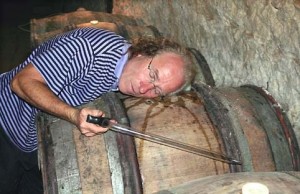
Jean Pierre Robinot is a wine grower in the Loire Valley. Here you can read about his organic farming and non-interventionalist wine making. Scroll down towards the bottom of the page to hear the sound of fermenting wine! (wine geeks will love this):
“About 7 minutes of soundtrack with the bubbling of fermenting wine after the cellar master opens the door with his big keys.”
]]>